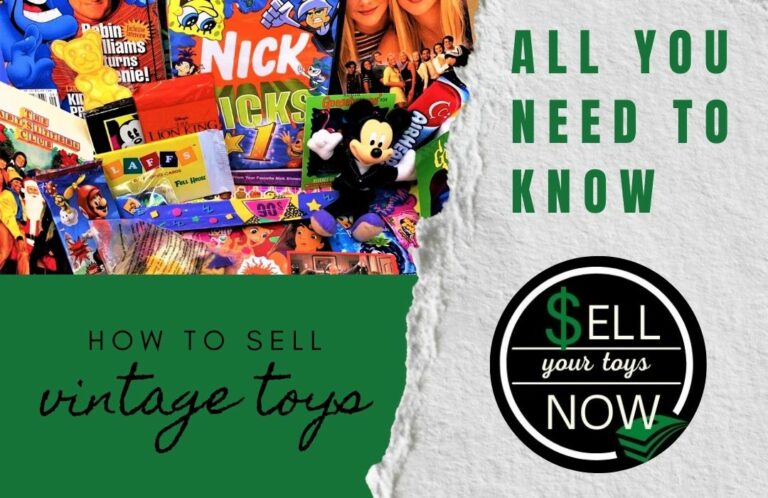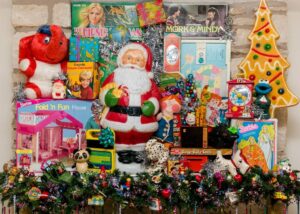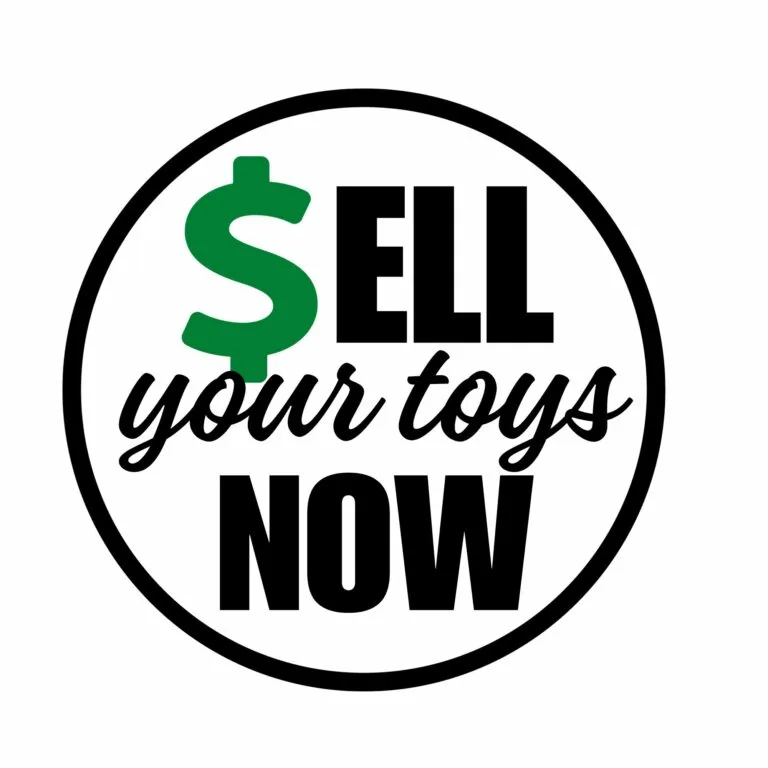How To Sell Vintage Toys - All You Need To Know

Welcome vintage toy enthusiasts! Selling old toys from decades past can be a fun and profitable hobby. This guide will provide tips for identifying valuable vintage toys, preparing them for sale, choosing sales platforms, pricing toys, and more. Read on to learn all you need to know about selling vintage toys!
The key to successfully selling your vintage toys is properly identifying desirable toys, refurbishing and cleaning them, then utilize SellYourToysNow.com to maximize your profits from your vintage toys. Alternatively, you can use online marketplaces such as eBay or Facebook Marketplace to get a smaller return on your investment.
Best Place to Sell Your Vintage Toys
Toy Buyers – SellYourToysNow.com
The best option is selling directly to toy and collectible buyers like us at SellYourToysNow.com. We purchase a wide selection of new and used vintage toys for top dollar. Benefits of selling to toy buyers like us include:
Free valuation and prepaid shipping – We provide quotes and provide shipping labels for free.
Speed and convenience – Our team handles photography, listings, and sales so you can cash out fast.
Competitive payouts – We pay highly competitive rates based on condition and demand. Rare and vintage sets pay the most.
Direct payouts – Once we receive your toys, payouts are issued quickly, avoiding marketplace payment holds.
By streamlining the entire selling process, you can conveniently liquidate your vintage doll collection for cash with minimal effort.
Sell Your Vintage Toys at Sell Your Toys Now
At Sell Your Toys Now, we remove the complication from selling your dolls, toys, and action figures. If you have a vintage toy collection in good condition, and you want to earn money from that investment, reach out to our team today.
How To Sell Your Vintage Toys Fast With Us
Step 1: CONNECT: Let us know what vintage toys you want to sell.
We have many options. You can email, use our app, submit photos, submit a list, or use our toy pricer. This will give us a better idea of what you’re selling.
Step 2: GET A QUOTE: Receive a quote from Sell Your Toys Now.
Within two business days, our staff will evaluate your collection and respond to you with an offer to buy your toy collection.
Step 3: SEND & GET PAID: Ship your collection to receive payment.
If you are satisfied with our quote, you can accept the offer. We will then send you detailed instructions on how to package and ship your items.
We pay for the shipping and provide shipping labels. Once your items are checked in at our warehouse, you should receive payment within 48 hours. We pay via check, Venmo, or PayPal.
How To Identify the Value of Your Vintage Toys
The first step to selling vintage toys is identifying which toys are worth selling in the first place. While some old playthings end up donated or thrown away, certain vintage toys are highly sought after by collectors. When identifying potentially valuable toys, consider the following:
Popularity and Nostalgia
Toys that were popular back in their heyday often appeal to adult collectors who feel nostalgia towards beloved childhood toys. Dolls like Barbie, iconic action figures like GI Joe, classic games like Hungry Hungry Hippos, and more tend to sell well.
Even vintage toy brands that have stood the test of time like Lego, Fisher-Price and Hot Wheels have collectors markets.
Condition
The condition of vintage toys greatly impacts value. Toys still sealed in original packaging or in like-new shape tend to sell for much more. Conversely, heavily worn/damaged toys have lower demand.
Evaluate wear, missing pieces, working condition for toys with mechanical parts, etc. Pristine shape commands premium prices.
Rarity
Vintage toy collectors pay big bucks for extremely hard-to-find toys in great condition. Limited edition toys, short-lived toy lines, early iterations of popular brands, accidentally misprinted packaging variants, regional test market releases, and toys using unique materials all appeal to collectors. Research is key for spotting rare finds.
Completeness
Toys sold together with all original accessories, boxes, paperwork, etc. achieve higher sale prices than incomplete loose items. If you have complete sets, bell them together instead of piecing them out for maximum profit.

Refurbishing and Cleaning Toys
Before selling vintage toys, a deep cleaning and some restoration work can significantly boost value. Follow these best practices:
Carefully Clean
Use mild cleaners and gentle techniques tailored to material types to properly clean. Avoid harsh chemicals that could damage delicate materials like tin or celluloid.
Research First for Rare Items
Do research before attempting restoration on rare toys. In some cases, restoration reduces value for collectors who want items preserved in their original state showing natural wear.
Replace Consumables
For toys with perishable parts like rubber bands in tin wind-up toys, replace worn consumable elements. This improves appearance and function.
Touch Up Paint
For toys with minor paint wear, carefully touch up spots using correct colors of hobby paint to improve appearance. Avoid over-painting original paint.
Fix Broken Pieces
Repair, reglue, or replace any broken, cracked or missing plastic, wood or metal toy components. Carefully match colors and materials. Avoid obvious glue showing.
Following these steps makes toys more attractive and valuable to buyers. But take care not to overtly restore to like-new conditions for certain high-value collectors’ markets.
Choosing Sales Platforms
Selling refurbished vintage toys requires selecting profitable sales channels that connect you with interested toy buyers. Good options include:
eBay
As the largest auction marketplace, eBay offers unmatched access to millions of vintage toy collectors. Successful eBay selling requires strong photos, detailed descriptions of flaws, and fair pricing based on toy exact condition and sold comps.
However, selling on ebay comes with some pitfalls. eBay charges 12% for toys categories in addition to further PayPal payment fees typically totaling 15% that significantly eat into profits.
While the massive eBay marketplace grants unmatched access to buyers, the multitudes of sellers leads to intense price-based competition to attract bids, driving down potential markups.
Web-only interactions without the ability to see, touch, or examine toys prior to purchase leads to inaccurate expectations from buyers, more returns, and an increased number of misleading listings and counterfeit toys slipping through eBay’s policies.
Facebook Marketplace
Facebook’s local pickup marketplace provides a platform to conveniently sell to nearby collectors. Pricing can aim slightly higher than eBay since buyers save on shipping costs.
Specialized Online Forums
Joining and selling in dedicated vintage toy collector forums like Figures.com taps into an audience already hunting for specific toys. These niche groups allow higher premiums but have smaller buyer pools.
Conventions and Shows
Renting dealer table space at a major vintage toy show enables selling directly to passionate collectors in-person during a limited convention run. This route requires upfront costs and travel but brings in buyers eager to spend.
Local Vintage Toy Stores
Building relationships with independent vintage toy store owners in your region provides an avenue to directly sell toys through their brick-and-mortar shops for solid profits you share via an agreed upon consignment split.
Pricing Toys
Properly pricing vintage toys based on verified value ranges ensures good profits while maintaining fair prices that move product. When valuing toys for sale, reference the following:
Use Our Proprietary Instant Toy Quote Software
Our instant toy pricer is a fantastic tool for getting an instant quote from your vintage toys. Simply select the brand, make/model and get an instant quote!
Sales History on eBay and Other Platforms
Study the sold listing prices over the past 3 months for your exact toy in the same condition on eBay and specialty forums to gauge real-world value based on what informed collectors recently paid.
Price Charting Services
Use aggregate pricing data tools like 130Point.com to see averaged used sale prices, giving you an accurate ballpark range. This beats relying on inflated manufacturer suggested prices or loose seller claims.
Condition Scales
Rate each toy’s condition on the standard Near Mint to Poor 1-10 scale and price accordingly based on deductions for damage and completeness issues. Add rarity premiums for hard-to-find high-demand toys.
Authentication
For extremely rare finds, consider professional authentication services like A Certified Guaranty Company (ACG) which provides condition grades and certification paperwork proving authenticity, bolstering value.
Taking these pricing factors into account when attaching asking prices to vintage toys helps maximize profits. Adjust as needed based on response and your profit goals.
Providing Great Customer Service
Delivering exemplary customer service ensures your reputation and repeat business. Best practices include:
Detailed Descriptions
Note all flaws upfront, avoiding negative surprises that lead to returns and complaints. Quantify damage and defects while still presenting toys in their best light. Manage expectations accurately.
Professional Packaging
Pack toys with extreme care to prevent shipping damage using appropriate materials and snug fit. This provides peace of mind to distant buyers relying on intact delivery.
Quick Shipping
Mail toys out immediately to show you value buyers’ time. This encourages positive reviews. Offer tracking info for reassurance.
Respond Promptly
Reply quickly and politely to buyer messages answering questions or resolving any minor issues. This customer focus cements your trusting relationship.
Reasonable Return Policy
Back your vintage toys with a 30 day return window and provide hassle-free refunds if a toy has an undetected major defect unknown to the buyer on purchase. This good faith keeps loyal repeat customers.
Authenticating Rare Finds
As you hunt for potentially valuable vintage toys, you may occasionally uncover what appears to be an extremely rare toy in incredible condition. How can you determine if your find is truly authentic versus a well-made fake? Professional authentication services are invaluable for spectacular, high-dollar toy finds.
The most reputable vintage toy authentication company is A Certified Guaranty Company (ACG), offering certification for virtually all toys, games, and collectibles.
Submitted items undergo rigorous inspection from trained specialists checking for appropriate materials, manufacturing techniques consistent with the original production era, wear patterns aligned to purported age, accurate branding applications, appropriate accessory inclusions, and more.
Toys successfully vetted by this exhaustive process receive attractive display-worthy certification paperwork encapsulating the toy’s photo stating details like description, designated category, declared rarity, year of manufacture, dimensional sizing, and overall condition grade.
Receiving a top-tier grade certification from a respected authority like ACG immediately increases perceived value and buyer trust.
For particular high ticket toy finds projected to sell for over $10,000, consider getting a second certification opinion from White’s Toy Authentication or Jerry’s Authentications, which offer similar professional authentication services that make judgments completely independently from any other existing certification.
Dual agreement between services that a toy is genuine carries tremendous weight with vintage toy investors.
Fees for authentications understandably rise along with sticker price values, but the cost almost always pays for itself in the eventual expanded sale revenue these certifications enable.
Do not leave extreme money on the table for your best vintage toy picks by trying to sell them uncertified and having skeptical buyers unable to validate legitimacy. Paying for professional authentication delivers peace of mind and profit.
Safely Storing Inventory
As your vintage toy selling operation grows with an expanding inventory sourced from various avenues like flea markets, estate sales, and collector auctions, proper storage techniques become necessary to securely house your valuable stock in optimal condition. Follow these research-backed guidelines when storing toys awaiting sale:
Control Temperature and Humidity
Consistent ambient room temperature between 65-75 degrees Fahrenheit and a relative humidity range from 30-40% provides ideal conditions to prevent material degradation issues for delicate vintage toy components vulnerable to heat damage or moisture-induced warping.
Avoid Sunlight Exposure
Bright ultraviolet light accelerates fading and material breakdown. Store toys in banker’s boxes or display cases away from windows and direct lighting. Fluorescent tubes also emit small amounts of UV rays, so avoid overhead fixtures.
Carefully Shelve Toys
Use fixed secure shelving units instead of unstable basic wire racks. Anchor tall shelving to walls for earthquake safety and install raised lips along shelf edges to prevent items sliding off. Group smaller loose parts in labeled clear containers near associated toys.
Control Pests
Inspect incoming toys for insect infestations before introducing them. Store fabrics in sealed bins. Position sticky traps and monitor for signs of issues. Address any problems immediately with freezing treatments or fumigation by an exterminator – laxity risks total inventory loss.
Security & Monitoring
Install an alarm system, surveillance cameras, and dual-key access requiring two keys to enter your vintage toy storage area. Log access dates and inventory locations. Perform periodic checks noting inventory condition and quantities to identify any developing problems like leaks/flooding, pest damage, or security breaches.
While elaborate, these research-verified precautions defend your vintage toy assets and business continuity against a variety of risks from simple mechanical damage to outright criminal theft. Protect your inventory investment.
Writing Accurate Descriptions
One key skill every successful high-volume vintage toy seller must master is writing compelling, honest product descriptions efficiently conveying condition, flaws, and appeal to potential buyers perusing listings. Follow proven tips to write better descriptions:
Adopt Consistent System
Craft organized descriptions adhering to set categories covering manufacturer, product name, model number, year released, dimensions, completeness, damage commentary, flaws, restoration notes, etc. Standardized formats help buyers understand specifics at a glance.
Take Lots of Photos
They say a picture speaks 1000 words. Capture multiple crisp clear photos under bright lighting at multiple angles to show the entire toy and all sides, including any defects. Zoom in on damage areas but maintain full context. Good photos reduce excessive written elaboration needing to explain subtleties.
Note Imperfections
Upfront disclose any flaws, missing elements, repairs, wear etc. This manages expectations, builds trust in your honesty, and reduces nasty post-sale disputes. Quantify and locate defects. But follow flaws with positive commentary about remaining strong points.
Use Searchable Keywords
Work verbatim toy name, key descriptive terms, relevant nostalgic properties, character names, etc. organically into descriptions for enhanced discovery via search engines. This drives views and bids.
Writing great descriptions does demand significant upfront effort improving over time with experience. But clear, consistent, compliant, keyword-rich descriptions raise bids, build reputation, and repay the work long-term via increased sales and larger profits.
Conclusion
Selling vintage toys allows you to turn childhood nostalgia into real profits by tapping into the thriving collectors’ market. Follow this guide to identify desirable toys, properly restore them, utilize the best sales platforms, accurately price toys to market rates, and offer stellar customer experiences.
Attention to detail in selecting and handling quality toys matched only by your dedication to customer service will let you thrive in this fun and rewarding hobby-turned-business.
Frequently Asked Questions
What vintage toys tend to be the most valuable to collectors?
Generally the most valuable vintage toys are major iconic toy brands (like Barbie, Hot Wheels, Lego, etc.) in mint complete-in-box condition, limited edition/short run toys, toys with production quirks/variants, items exclusive to regional test markets, and utterly rare toys few collectors have seen before.
Is it ok to restore vintage toys or should I sell them as-is?
Light cleaning and repairs are fine, but avoid overtly restoring toys to like-new condition. Significant collector value lies in original paint and natural slight wear showing the toy’s history.
Heavily played-with examples can be left as-is for buyers wanting affordably-priced toys for actual child play. Gently meet somewhere in the middle range.
What general eras of toys tend to be most collectible?
Typically toys made from the 1950s through the 1980s fall into the current sweet spot eras for vintage toy collectors heavily driven by Gen X and Millennials feeling nostalgia for their youth.
But older antique toys from the late 1800s through 1940s also command premium pricing amongst specialized collectors.
Are vintage toy prices falling due to all the childhood toys aging Baby Boomers try to sell?
Prices have seen some declines in common mass-produced toys as more supply enters markets, but truly rare mint condition toys unaffected by over-saturation continue selling at record high values. Focus on corners of the vintage toy market with high demand from passionate collectors to maximize profit potential.
